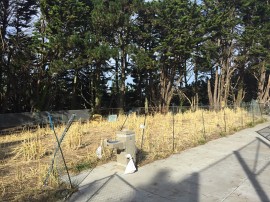After the longstanding drought, you might think trees could use all the rain they can get. Though it’s true that trees can use and store water for later use, excessive precipitation can cause significant problems and potentially kill your trees and landscaping. Tree inspections are critical after heavy rains to ensure no damage has occurred. What signs should you look for to determine tree damage and potential hazards?
Saturated Soil or Standing Water
Water accumulation is often the first sign of danger in heavy rains, increasing the likelihood that tree roots will fail in high winds and fall. Additionally, pooling water surrounding the tree base prevents oxygen from penetrating roots, saturating the tree within hours. Roots begin to die in just days, impacting tree health and safety.
Exposed Roots or Leaning Trees
Flooding and runoff may expose roots, causing trees to become unstable or lean. Water weight only adds to the stress. Always avoid leaning trees. Falling trees can cause significant property damage and bodily harm. With help from our plant health care experts, you may be able to support and save these trees. Unfortunately, in some situations, tree removal may be necessary for safety.
Trunk and Branch Damage
Cracks in the trunk more than a few inches long extending through the bark and into the wood or cracks on more than one side from precipitation extremes weaken trunk stability, making collapse likely. Cracks near damaged or rotten trunk sections or in the ‘V’ of multi-trunk trees are hazardous and require immediate attention from your local emergency tree service.
Cracked and split branches, especially partially attached or lodged hangers, are also in danger of falling. Limbs may not look large from afar but will prove to be sizeable and hefty once fallen, posing a hazard to nearby people and property. You should have these branches removed by our landscape contractors as soon as possible to protect yourself against liability.
Fungal Growth, Decayed Pockets, Pests, and Disease
Watch for signs like mushrooms and conks growing in tree bark and decaying tree cavities. Moist environments increase the likelihood of fungal infections like root rot and anthracnose. Ailing trees and wet wood also attract pests. To avoid spreading the problem or weakening tree structure, never attempt to remove these yourself. Our landscape renovation team can help you mitigate the environmental and soil conditions that set the stage for these issues and forge the path to a healthy, vibrant landscape.
Safety Tips for Inspecting Trees After Heavy Rain
Storm damaged trees pose a serious safety risk. Always wear head protection before approaching trees. Begin your inspection from a safe distance, from the ground. Avoid the area if you see or suspect hazards like falling branches, exposed roots, or leaning trees. When in doubt, leave the inspection to an experienced arborist or landscape maintenance professional.
Have Your Trees Assessed by a Pro
Tree inspections are critical after heavy rains. Gachina’s landscape management professionals know how to quickly identify tree health and safety issues following extreme weather events – and how to prepare your landscape to weather the storm. Commercial property owners and managers throughout the Bay Area, from Gilroy to San Francisco, and from San Jose to Livermore and Walnut Creek, rely on us for professional landscape management services. Contactus at 650-853-0400 to schedule a tree assessment or post-storm landscape maintenance for your commercial property today.






